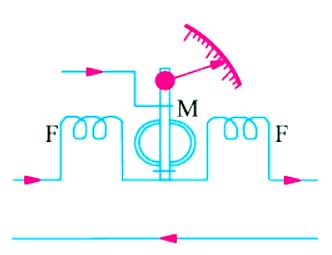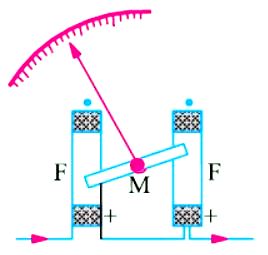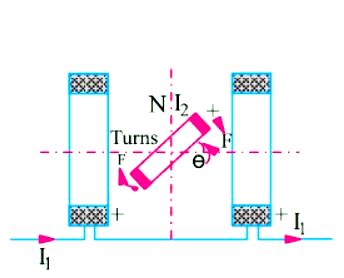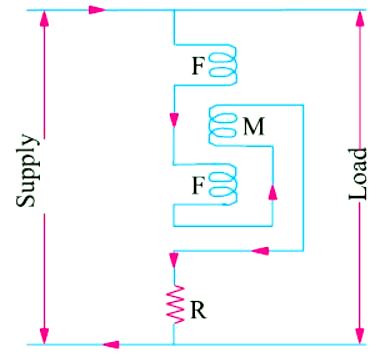Moving coil Instruments - Dynamometer type instrument
There are two types of Moving coil Instruments (i) Moving coil Instruments – permanent magnet moving Coil type (PMMC) which can be used for D.C. work only and (ii) Moving coil Instruments – Dynamometer type instrument which can be used both for A.C. and D.C. work.
Dynamometer Type Instruments
An electrodynamic instrument is a moving-coil instrument in which the operating field is produced, not by a permanent magnet but by another fixed coil. This instrument can be used either as an ammeter or a voltmeter but is generally used as a wattmeter.
As shown in Figure (A) & (B), the fixed coil is usually arranged in two equal sections F and F placed close together and parallel to each other. The two fixed coils are air-cored to avoid hysteresis effects when used on A.C. circuits. This has the effect of making the magnetic field in which moves the moving coil M, more uniform. The moving coil is spring-controlled and has a pointer attached to it as shown.


Deflecting Torque
The production of the deflecting torque can be understood from Figure (C). Let the current passing through the fixed coil be I1 and that through the moving coil be I2. Since there is no iron, the field strength and hence the flux density is proportional to I1.
∴ B = KI1 where K is a constant
Let us assume for simplicity that the moving coil is rectangular (it can be circular also) and of dimensions l × b. Then, force on each side of the coil having N turns is (NBI2l) newton. The turning moment or deflecting torque on the coil is given by
Td = NBI2lb = NKI1I2lb N-m
Now, putting NKlb = K1, we have Td = K1I1I2 where K1 is another constant.
AdBlock-2

It shows that the deflecting torque is proportional to the product of the currents flowing in the fixed coils and the moving coil. Since the instrument tis spring-controlled, the restoring or control torque is proportional to the angular deflection θ.
i.e. Tc ∝ = K2θ
∴ K1I1I2 = K2θ
or
θ ∝ I1I2
When the instrument is used as an ammeter, the same current passes through both the fixed and the moving coils as shown in Figure (D).
In that case I1 = I2 = I, hence θ ∝ I2 or I ∝ θ. The connections of Figure (C) are used when small currents are to be measured.
In the case of heavy currents, a shunt S is used to limit current through the moving coil as shown in Figure (E).

When used as a voltmeter, the fixed and moving coils are joined in series along with a high resistance and connected as shown in Figure (F).
Here, again I1 = I2 = I, where I = V/R
in D.C. circuits and
I = V/Z in A.C. circuits.
∴ θ ∝ V × V or θ ∝ V2 or V∝ θ
Hence, it is found that whether the instrument is used as an ammeter or voltmeter, its scale is uneven throughout the whole of its range and is particularly cramped or crowded near the zero.
Damping is pneumatic, since owing to weak operating field, eddy current damping is inadmissible. Such instruments can be used for both A.C. and D.C. measurements. But it is more expensive and inferior to a moving-coil instrument for D.C. measurements.

Errors
Since the coils are air-cored, the operating field produced is small. For producing an appreciable deflecting torque, a large number of turns is necessary for the moving coil. The magnitude of the current is also limited because two control springs are used both for leading in and for leading out the current. Both these factors lead to a heavy moving system resulting in frictional losses which are somewhat larger than in other types and so frictional errors tend to be relatively higher. The current in the field coils is limited for the fear of heating the coils which results in the increase of their resistance. A good amount of screening is necessary to avoid the influence of stray fields.

Advantages and Disadvantages
1. Such instruments are free from hysteresis and eddy-current errors.
2. Since (torque/weight) ratio is small, such instruments have low sensitivity
Read article – permanent magnet moving Coil type Instrument
Visit NCERTplanet.com for NCERT solutions and Textbook downloads




